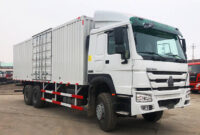7.3 Powerstroke Diesel Trucks For Sale: Your Ultimate Buyer’s Guide pickup.truckstrend.com
In the ever-evolving world of automotive technology, some legends simply refuse to fade. Among them, the Ford 7.3 Powerstroke diesel engine stands tall, an icon of reliability, durability, and raw power that continues to captivate truck enthusiasts and heavy-duty users alike. Despite being out of production for over two decades, the demand for 7.3 Powerstroke diesel trucks for sale remains remarkably strong, a testament to its enduring legacy. This comprehensive guide is designed to help you navigate the market for these highly sought-after workhorses, offering insights into what makes them special, what to look for, and how to make a smart purchase.
Why the 7.3 Powerstroke Still Reigns Supreme
7.3 Powerstroke Diesel Trucks For Sale: Your Ultimate Buyer’s Guide
The 7.3L Powerstroke, produced by Navistar International and used by Ford from 1994.5 to 2003, earned its legendary status for several compelling reasons:
- Unmatched Reliability: Often dubbed the "million-mile engine," the 7.3 Powerstroke is renowned for its robustness. Its mechanically injected, hydraulically actuated electronic unit injector (HEUI) system, while complex for its time, proved incredibly durable when properly maintained. Unlike many modern diesels, it lacks complex emissions equipment like Diesel Particulate Filters (DPFs) and Selective Catalytic Reduction (SCR) systems, which are common sources of costly failures in newer trucks.
- Simplicity and Maintainability: Compared to today’s highly electronic and emissions-laden diesels, the 7.3 is remarkably straightforward. This simplicity translates to easier diagnostics and more affordable repairs for common issues. Parts are widely available, and a vast community of owners and mechanics possesses extensive knowledge of these engines.
- Impressive Power and Torque: With factory ratings up to 275 horsepower and 525 lb-ft of torque (in its final iterations), the 7.3 Powerstroke provided ample power for its era. It’s more than capable of handling substantial towing and hauling tasks, making it a favorite for contractors, farmers, and RV enthusiasts.
- Fuel Efficiency (for its class): While not a Prius, the 7.3 Powerstroke generally delivers respectable fuel economy for a full-size diesel truck, often ranging from 15-20 MPG unladen, depending on gearing, tires, and driving style.
- Cost-Effectiveness: The initial purchase price of a used 7.3 Powerstroke is significantly lower than a new diesel truck. With its legendary longevity and relatively low maintenance costs, it offers an incredible return on investment for those needing a capable work vehicle without breaking the bank.

What to Look For When Buying a Used 7.3 Powerstroke
Purchasing any used vehicle requires diligence, but with a 7.3 Powerstroke, certain areas demand particular attention due to their age and intended use.
1. Exterior and Frame Inspection:
- Rust: This is often the biggest enemy of older trucks. Thoroughly inspect the frame, especially around suspension mounting points, spring perches, and crossmembers. Check rocker panels, cab corners, bed supports, and wheel wells for signs of extensive rust or shoddy repairs.
- Body Panels: Look for dents, scratches, and inconsistent paint, which might indicate past accidents or neglect.

2. Engine Condition (The Heart of the Beast):
- Cold Start: Have the seller start the truck cold. Listen for excessive cranking, rough idle, or thick white/blue smoke. A healthy 7.3 should start relatively quickly, even in cold weather (though some white smoke on a very cold start is normal until the engine warms).
- Oil Leaks: Common spots include valve covers, the High-Pressure Oil Pump (HPOP) lines and reservoir, front and rear main seals, and the turbo pedestal. Minor leaks might be acceptable, but significant drips indicate a need for repair.
- Coolant Leaks: Check the radiator, hoses, and water pump. Look for signs of "silicates" (white crusty residue) around hose connections.
- Turbocharger: Listen for excessive whine or grinding noises. Check for shaft play by trying to move the compressor wheel (a little in/out play is normal, but side-to-side play is bad).
- Blow-by: With the engine warmed up and running, remove the oil fill cap. A small amount of vapor is normal, but excessive "chugging" or smoke indicates worn piston rings.
- Maintenance Records: Crucial! Ask for detailed records of oil changes, fuel filter replacements, transmission fluid services, and any major repairs. A well-maintained truck is always a better investment.

3. Transmission and Drivetrain:
- Transmission: Test drive thoroughly. The automatic 4R100 transmission should shift smoothly without slipping, hesitation, or harsh clunks. Check the fluid color and smell – burnt fluid is a red flag. Manual transmissions (ZF5/ZF6) should shift cleanly without grinding, and the clutch should engage smoothly without slipping.
- Drivetrain: Check for unusual noises from the differentials or transfer case. Inspect U-joints for play. If it’s a 4×4, engage 4WD (both high and low range) to ensure it works properly.
4. Suspension and Steering:
- Steering Play: Excessive play in the steering wheel could indicate worn tie rods, ball joints, or a loose steering box.
- Shocks and Bushings: Look for leaky shocks and cracked or worn suspension bushings.
- Tires: Uneven tire wear can indicate alignment issues or worn suspension components.
5. Electrical and Interior:
- All Electronics: Test all lights, windows, locks, AC, heater, radio, and gauges. Ensure the "Wait to Start" light comes on and goes off as expected.
- Interior Condition: Assess wear and tear on seats, dashboard, and carpets.
6. Modifications:
- Be cautious of heavily modified trucks unless you have verifiable documentation of professional installation and tuning. Common modifications include tuners/chips, larger exhaust systems, intake systems, and upgraded injectors. While some can enhance performance, poor modifications can lead to premature wear or reliability issues.
Common Issues and Solutions (What to Expect)
No vehicle is perfect, and the 7.3 Powerstroke has a few well-documented quirks, most of which are easily remedied:
- Camshaft Position Sensor (CPS): A common failure point that can cause a sudden no-start or stalling. It’s an inexpensive and easy fix; many owners carry a spare.
- Exhaust Back Pressure Valve (EBPV): This valve can stick, causing excessive exhaust back pressure or a noisy rattle. Many owners opt to "delete" it, which simplifies the exhaust system.
- Injector Control Pressure (ICP) Sensor/Injector Pressure Regulator (IPR): Issues with these can lead to rough idle, stalling, or a no-start condition. Both are replaceable, though the IPR is more involved.
- Under Valve Cover Harness (UVCH): The harness inside the valve covers can rub and fray, causing misfires or dead cylinders. Replacing it often resolves these issues.
- Glow Plugs and Relay: Essential for cold starts. If the glow plug relay fails or glow plugs are burnt out, cold starting can be difficult.
- Fuel Pump: The mechanical fuel pump on older models or electric on later models can fail. An upgraded electric fuel pump (e.g., from a Super Duty) is a common reliability mod.
- Injector O-rings: Worn O-rings can cause oil to leak into the fuel system, leading to rough running or "cackle."
Many owners perform "preventative maintenance" upgrades such as the "Hutch and Harpoon" mods (improving fuel pickup and return in the tank), upgraded fuel filtration, and the addition of aftermarket gauges (EGT, Boost, Transmission Temp) to monitor critical engine parameters.
Where to Find 7.3 Powerstroke Trucks For Sale
- Online Marketplaces: Facebook Marketplace, Craigslist, and eBay Motors are prime hunting grounds. Be prepared to sift through many listings and filter by location.
- Used Car Dealerships: Some general used car lots might have them, but specialized diesel truck dealers are more likely to have well-inspected and sometimes even warrantied examples.
- Enthusiast Forums & Groups: Websites like Powerstroke.org, Diesel Truck Resource forums, and dedicated Facebook groups for 7.3 Powerstroke owners are excellent places to find well-maintained trucks from fellow enthusiasts.
- Word of Mouth: Let friends, family, and mechanics know you’re looking. Sometimes the best deals are found through personal connections.
Pricing Considerations for 7.3 Powerstroke Trucks
The price of a 7.3 Powerstroke truck can vary wildly based on several factors:
- Year and Trim Level: Later models (late 1999 to 2003) generally command higher prices due to updated interiors, improved engines (less prone to cavitation), and better transmissions. Higher trim levels (Lariat, King Ranch) also fetch more.
- Mileage: While the 7.3 is known for longevity, lower mileage examples (under 200k) will be more expensive.
- Condition: Rust-free bodies, clean interiors, and well-maintained mechanicals significantly increase value.
- Cab Configuration & Drivetrain: Crew cabs and 4×4 models are typically more desirable and thus more expensive.
- Geographical Location: Prices can vary regionally, often higher in areas with less rust.
- Modifications: Well-executed, desirable modifications (e.g., larger turbo, tuning from reputable shops, upgraded transmission) can add value, but cheap or questionable mods can detract from it.
Representative Price Guide for 7.3 Powerstroke Diesel Trucks For Sale
Please note: These prices are estimates and can fluctuate significantly based on market demand, location, and specific vehicle history.
| Year Range | Condition | Mileage Range (approx.) | Estimated Price Range (USD) | Key Features/Notes |
|---|---|---|---|---|
| 1994.5 – 1997 | Project/Rough | 300,000+ | $3,000 – $7,000 | Often high mileage, significant rust, needs major mechanical work. Good for parts or dedicated restoration. |
| 1994.5 – 1997 | Fair | 250,000 – 350,000 | $7,000 – $12,000 | Runs and drives, likely some rust, cosmetic flaws, and minor mechanical issues. Daily driver potential with some TLC. |
| 1999 – 2003 | Fair | 200,000 – 300,000 | $10,000 – $15,000 | Later body style, better engine/transmission. Expect some wear, minor issues. Solid work truck. |
| 1999 – 2003 | Good | 150,000 – 250,000 | $15,000 – $20,000 | Well-maintained, minimal rust, good running condition. Ready for regular use. |
| 1999 – 2003 | Excellent | Under 150,000 | $20,000 – $30,000+ | Rare find. Low mileage, pristine condition, possibly garaged, full service history. Collector’s item or premium workhorse. |
Practical Advice and Actionable Insights
- Get a Pre-Purchase Inspection (PPI): This is non-negotiable. Have a qualified, independent diesel mechanic (preferably one familiar with 7.3 Powerstrokes) inspect the truck thoroughly before you buy. This small investment can save you thousands.
- Don’t Rush: The market for 7.3s can be competitive, but patience pays off. Wait for the right truck that fits your budget and needs.
- Ask for Records: Always request maintenance records. A seller who can provide them shows they’ve cared for the vehicle.
- Test Drive Extensively:
- Start it cold.
- Drive at highway speeds, stop-and-go traffic, and engage 4WD if applicable.
- Listen for unusual noises, feel for vibrations, and check how the transmission shifts.
- Test all accessories.
- Be Realistic: These are old trucks. Expect some minor quirks, wear and tear, and possibly some immediate maintenance needs. Factor this into your budget.
- Budget for Post-Purchase Care: Even a "good" 7.3 might benefit from fresh fluids, filters, and a thorough once-over by your mechanic. Consider upgrading common failure points proactively.
Concluding Summary
The 7.3 Powerstroke diesel truck stands as a monument to engineering excellence and enduring utility. Its reputation for reliability, power, and relative simplicity makes it a highly desirable option for anyone seeking a capable and cost-effective heavy-duty vehicle without the complexities and emissions headaches of modern diesels. While buying a used truck always comes with risks, approaching the purchase of a 7.3 Powerstroke with diligence, knowledge, and a keen eye for detail will significantly increase your chances of finding a true gem. Invest wisely, maintain it well, and your 7.3 Powerstroke will serve you faithfully for hundreds of thousands of miles to come, proving that some legends truly never die.
Frequently Asked Questions (FAQ) about 7.3 Powerstroke Diesel Trucks
Q1: Is the 7.3 Powerstroke really as reliable as people say?
A1: Yes, absolutely. It’s widely regarded as one of the most reliable diesel engines ever produced for light-duty trucks. Its mechanical simplicity and robust design contribute to its legendary longevity, often reaching 500,000 miles or more with proper maintenance.
Q2: What’s the "best" year for the 7.3 Powerstroke?
A2: Most enthusiasts prefer the "late 1999 to 2003" models. These engines feature larger turbochargers, better injectors, and a more robust block design, along with updated interiors and improved 4R100 transmissions.
Q3: How many miles can a 7.3 Powerstroke last?
A3: It’s common to see 7.3 Powerstrokes with 300,000 to 500,000 miles still running strong. With meticulous maintenance, some have even surpassed the "million-mile" mark.
Q4: Are parts still available for the 7.3 Powerstroke?
A4: Yes, parts availability is excellent. Due to the engine’s popularity and long production run, OEM, aftermarket, and used parts are readily accessible through various suppliers, dealerships, and online retailers.
Q5: Is the 7.3 Powerstroke good for towing?
A5: Absolutely. With its ample torque and durable construction, the 7.3 Powerstroke is an excellent towing platform. It can comfortably handle travel trailers, fifth-wheel campers, car haulers, and utility trailers within its rated capacities.
Q6: What kind of fuel economy can I expect from a 7.3 Powerstroke?
A6: Fuel economy varies depending on the truck’s configuration (2WD/4WD, gearing, tire size), driving style, and load. On average, you can expect 15-20 MPG unladen on the highway, and 10-14 MPG while towing heavy loads.
Q7: Should I buy a modified 7.3 Powerstroke?
A7: Exercise caution. While some modifications (like a better fuel system or gauges) can be beneficial, heavily modified trucks with aggressive tunes, large turbos, or non-stock injectors should be thoroughly inspected by a professional. Poorly executed modifications can significantly reduce engine life and reliability. Prioritize trucks with verifiable professional modifications and proper supporting upgrades.
![]()


